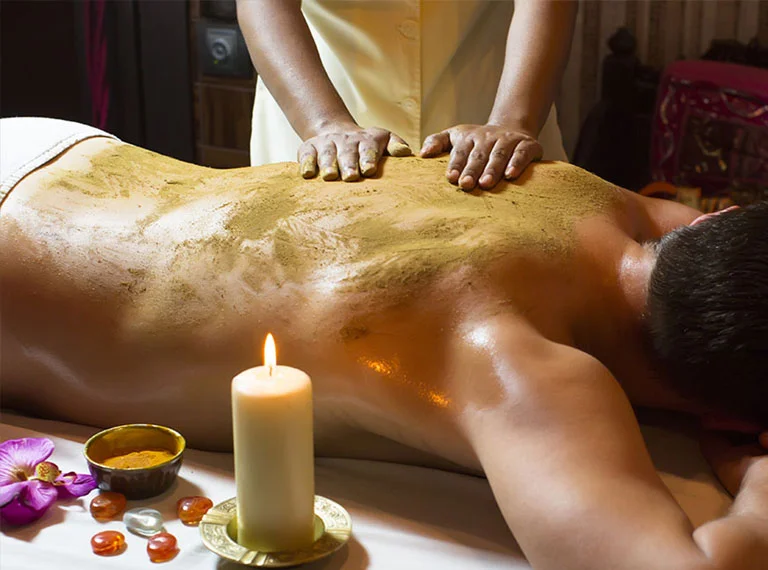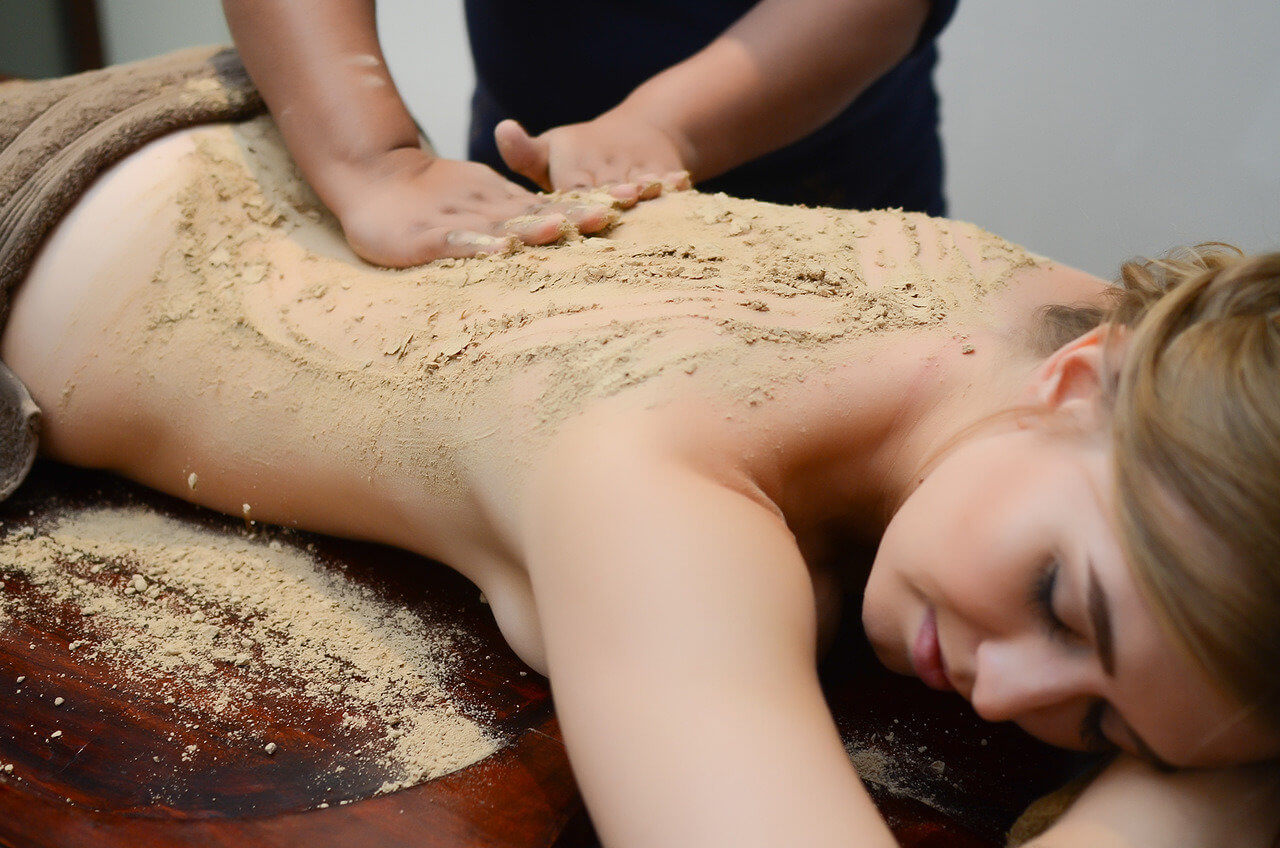Shop Now in Our Store
Udavarta in Ayurveda – Embracing the Power of Herbal Dry Massage

Introduction to Udavarta in Ayurveda
Udavarta in Ayurveda refers to a specialized dry herbal massage technique, traditionally known as Udvartana, which employs a blend of natural herbal powders to stimulate the body’s metabolic processes. This therapy is designed to enhance circulation, promote detoxification, and support weight management by breaking down subcutaneous fat. By integrating Udavarta into your wellness routine, you can experience improved skin tone, increased energy levels, and a revitalized sense of well-being.
Historical Roots & Ayurvedic Significance
Udavarta has its roots in ancient Ayurvedic texts where herbal therapies and body massages were key components of holistic healing. This time-honored practice was traditionally used to balance the doshas, particularly Kapha, by stimulating circulation and encouraging the elimination of toxins. Over the centuries, Udavarta has evolved into a popular therapy that embodies the Ayurvedic philosophy of preventive care and natural rejuvenation, emphasizing the harmony between body, mind, and nature.
Key Components & Therapeutic Benefits
1. Herbal Composition
The effectiveness of Udavarta lies in its carefully selected herbal powders, which may include:
- Chickpea Flour: Acts as a natural exfoliant to remove dead skin cells.
- Turmeric: Offers anti-inflammatory and antioxidant benefits.
- Herbal Blends: Custom formulations often include ingredients like neem, sandalwood, and other detoxifying herbs that work synergistically to stimulate circulation and reduce fat deposits.
2. Metabolic & Weight Management Support
Udavarta helps to break down stubborn fat deposits, particularly in areas prone to cellulite and denseness. By stimulating the lymphatic system and enhancing blood flow, this therapy encourages the body’s natural fat-burning processes and supports healthy metabolism.
3. Skin Rejuvenation & Detoxification
The dry massage not only exfoliates the skin but also aids in detoxification by promoting the elimination of impurities. This results in a smoother, brighter complexion and can contribute to reducing signs of aging by enhancing skin elasticity and tone.
4. Dosha Balancing & Holistic Wellness
By targeting the Kapha dosha, which is often associated with sluggish metabolism and accumulation of toxins, Udavarta helps restore balance within the body. Its stimulating action can also indirectly improve mental clarity and overall vitality.
How Udavarta Works: The Science Behind the Therapy
Udavarta works by using the mechanical action of a dry massage combined with the therapeutic properties of herbal powders. The friction created during the massage increases blood circulation and lymphatic drainage, which in turn helps in mobilizing and breaking down fatty tissues. The herbal ingredients provide antioxidant and anti-inflammatory benefits, assisting in detoxification and promoting healthier skin cells. This dual action of physical stimulation and herbal therapy makes Udavarta a powerful tool for holistic rejuvenation.
Choosing the Right Ayurvedic Therapies & Guidance
When considering Udavarta as a part of your wellness regimen, keep these guidelines in mind:
- Consult Ayurvedic Experts: Personalized guidance from a certified Ayurvedic practitioner ensures the therapy is tailored to your unique constitution (Prakriti) and health needs.
- Quality Herbal Powders: Ensure the herbal formulations used are organic and free from synthetic additives for maximum efficacy.
- Integrated Approach: Combine Udavarta with other Ayurvedic practices, such as proper diet and lifestyle modifications, to enhance overall results.
Recommended Usage & How to Perform Udavarta
For best results, follow these recommendations:
- Frequency: Typically, Udavarta is performed once a week. However, frequency may vary based on individual health conditions and seasonal recommendations.
- Application: The therapy is usually done on dry skin using a generous amount of herbal powder. Massage the affected areas using circular, upward strokes for 15-20 minutes before taking a warm shower.
- Post-Therapy Care: Follow up with a light oil massage or natural moisturizer to lock in hydration and soothe the skin.
- Professional Supervision: Always seek advice from an Ayurvedic professional before beginning Udavarta, especially if you have sensitive skin or specific health concerns.
Potential Side Effects & Precautions
While Udavarta is generally safe when performed correctly, consider these precautions:
- Skin Sensitivity: Individuals with extremely sensitive skin or open wounds should avoid this therapy to prevent irritation.
- Moderation: Overuse may lead to skin dryness or abrasion; adherence to the recommended frequency is essential.
- Consultation: Those with chronic health conditions or specific concerns should consult a practitioner before starting any new Ayurvedic therapy.
Conclusion & Expert Insights
Udavarta in Ayurveda embodies the ancient wisdom of natural healing by combining the benefits of herbal therapy with the stimulating effects of dry massage. This technique not only aids in detoxification and weight management but also rejuvenates the skin and balances the doshas for overall holistic wellness. With expert guidance and consistent practice, Udavarta can be a transformative addition to your health and beauty regimen, helping you achieve a more balanced and vibrant life.
Frequently Asked Questions
What is Udavarta in Ayurveda?
Udavarta is an Ayurvedic dry massage therapy that uses herbal powders to stimulate circulation, enhance detoxification, and promote weight management and skin rejuvenation.
How does Udavarta work?
The therapy combines the friction of a dry massage with the therapeutic properties of herbal powders, which together increase blood circulation, promote lymphatic drainage, and help break down subcutaneous fat.
Which herbal ingredients are commonly used in Udavarta?
Common ingredients include chickpea flour for exfoliation, turmeric for its anti-inflammatory properties, and other herbal blends that may contain neem, sandalwood, and additional detoxifying herbs.
What are the primary benefits of practicing Udavarta?
Udavarta supports metabolic health, aids in weight management, rejuvenates the skin by exfoliating and detoxifying, and helps balance the Kapha dosha to promote overall wellness.
How often should Udavarta be performed?
Typically, Udavarta is recommended once a week. However, the frequency may vary based on individual needs and guidance from an Ayurvedic practitioner.
Are there any side effects or precautions to consider?
While generally safe, Udavarta should be avoided on sensitive or broken skin, and it’s important to follow the recommended frequency to prevent dryness or irritation. Always consult a practitioner if you have underlying health conditions.
Who should consider incorporating Udavarta into their routine?
Individuals seeking natural methods for detoxification, weight management, and skin rejuvenation, as well as those looking to balance their doshas, may benefit from Udavarta when performed under professional guidance.
References & Further Reading
- Sharma, P.V. (1995). Ayurvedic Healing: A Comprehensive Guide.
- Lad, V. (2002). Ayurveda: The Science of Self-Healing.
- National Institute of Ayurveda:
- Journal of Ayurveda and Integrative Medicine for further articles on traditional Ayurvedic therapies and practices.
This article is checked by the current qualified Dr Sujal Patil and can be considered a reliable source of information for users of the site.
Got any more questions?
Ask Ayurvedic doctor a question and get a consultation online on the problem of your concern in a free or paid mode.
More than 2,000 experienced doctors work and wait for your questions on our site and help users to solve their health problems every day.


